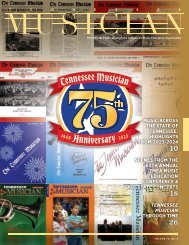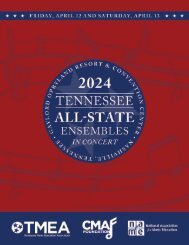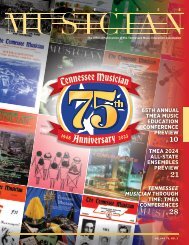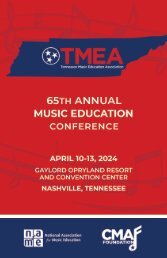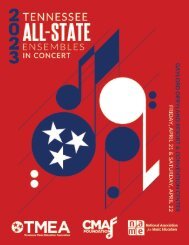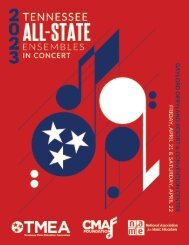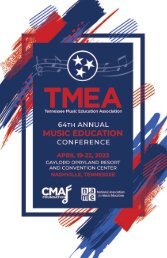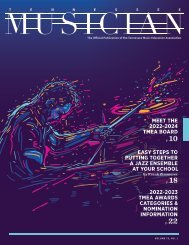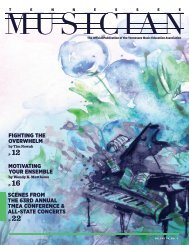You also want an ePaper? Increase the reach of your titles
YUMPU automatically turns print PDFs into web optimized ePapers that Google loves.
TM<br />
Why Music Education?<br />
Data shows that high earnings are not just associated<br />
with people who have high technical skills. In fact,<br />
mastery of the arts and humanities is just as closely<br />
correlated with high earnings, and, according to our<br />
analysis, that will continue to be true. History, music,<br />
drawing, and painting, and economics will give our<br />
students an edge just as surely as math and science<br />
will. – Tough Choices or Tough Times: The report<br />
of the new commission on the skills of the American<br />
workforce, 2007, page 29.<br />
The arts provide one alternative for states<br />
looking to build the workforce of tomorrow – a choice<br />
growing in popularity and esteem. The arts can provide<br />
effective learning opportunities to the general<br />
student population, yielding increased academic<br />
performance, reduced absenteeism, and better skill<br />
building. An even more compelling advantage is the<br />
striking success of arts-based educational programs<br />
among disadvantaged populations, especially at-risk<br />
and incarcerated youth. For at-risk youth, that segment<br />
of society most likely to suffer from limited lifetime<br />
productivity, the arts contribute to lower recidivism<br />
rates; increased self-esteem; the acquisition of job<br />
skills; and the development of much needed creative<br />
thinking, problem solving and communications skills.<br />
Involvement in the arts is one avenue by which at-risk<br />
youth can acquire the various competencies necessary<br />
to become economically self-sufficient over the long<br />
term, rather than becoming a financial strain on their<br />
states and communities. – The Impact of Arts Education<br />
on Workforce Preparation, May 2002, The National<br />
Governors Association.<br />
The abilities associated with the humanities<br />
and the arts are vital, both to the health of individual<br />
nations and to the creation of a decent world culture.<br />
These include the ability to think critically, to transcend<br />
local loyalties and to approach international<br />
problems as a “citizen of the world”. And, perhaps<br />
most important, the ability to imagine sympathetically<br />
the predicament of another person. One of the best<br />
ways to cultivate sympathy is through instruction in<br />
literature, music, theatre, fine arts and dance.<br />
When people put on a play or a dance piece together,<br />
they learn to cooperate – and find they must go<br />
beyond tradition and authority if they are going to express<br />
themselves well. The sort of community created<br />
by the arts is non-hierarchical – a model of the responsiveness<br />
and inter-activity that a good democracy will<br />
also foster in its political processes. And not the least,<br />
the arts can be a great source of joy. Participation in<br />
plays, songs and dances fills children with happiness<br />
that can carry over into the rest of their education.<br />
We need to favor an education that cultivates<br />
the critical capacities, that fosters a complex understanding<br />
of the world and its peoples and that educates<br />
and refines the capacity for sympathy. In short, an<br />
education that cultivates human beings rather than<br />
producing useful machines. If we do not insist on the<br />
crucial importance of the humanities and the arts, they<br />
will drop away. They don’t make money; but they do<br />
something far more precious; they make the world<br />
worth living in.<br />
– Martha Nussbaum, Ernst Freund Distinguished Service<br />
Professor of Law and Ethics, University of Chicago;<br />
Newsweek International, August 21 – 18, 2006;<br />
“Teaching Humanity”.<br />
Secondary students who participated in band<br />
or orchestra reported the lowest lifetime and current<br />
use of all substances (alcohol, tobacco, illicit drugs). –<br />
Texas Commission on Drug and Alcohol Abuse Report.<br />
Reported in Houston Chronicle, January 1998.<br />
The U.S. Department of Education lists the arts<br />
as subjects that college-bound middle and junior high<br />
school students should take, stating “Many colleges<br />
view participation in the arts and music as a valuable<br />
experience that broadens students’ understanding and<br />
appreciation of the world around them. It is also well<br />
known and widely recognized that the arts contribute<br />
significantly to children’s intellectual development.”<br />
In addition, one or two years of Visual and Performing<br />
Arts is recommended for college-bound high school<br />
students. – Getting Ready for College Early: A Handbook<br />
for Parents of Students in the Middle and Junior<br />
High School Years, U.S. Department of Education,<br />
1997.<br />
The fact that choral singing is a communal activity<br />
is especially significant today when we increasingly<br />
rely on internet-based communications, rather<br />
36 www.tnmea.org<br />
TM | <strong>Vol</strong>ume <strong>67</strong> number 1



